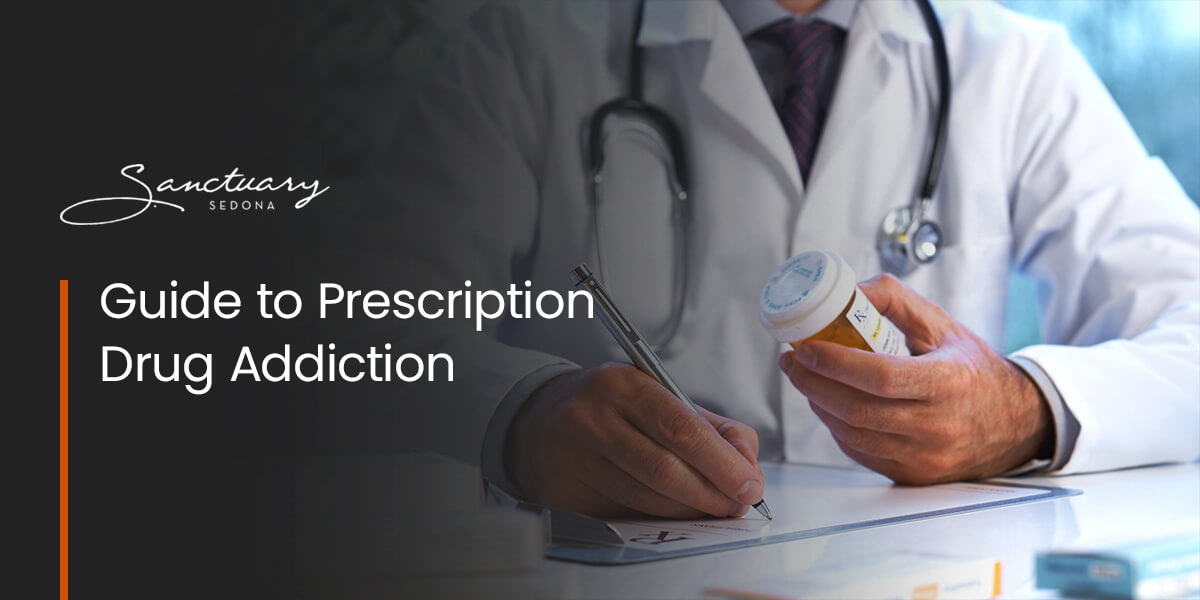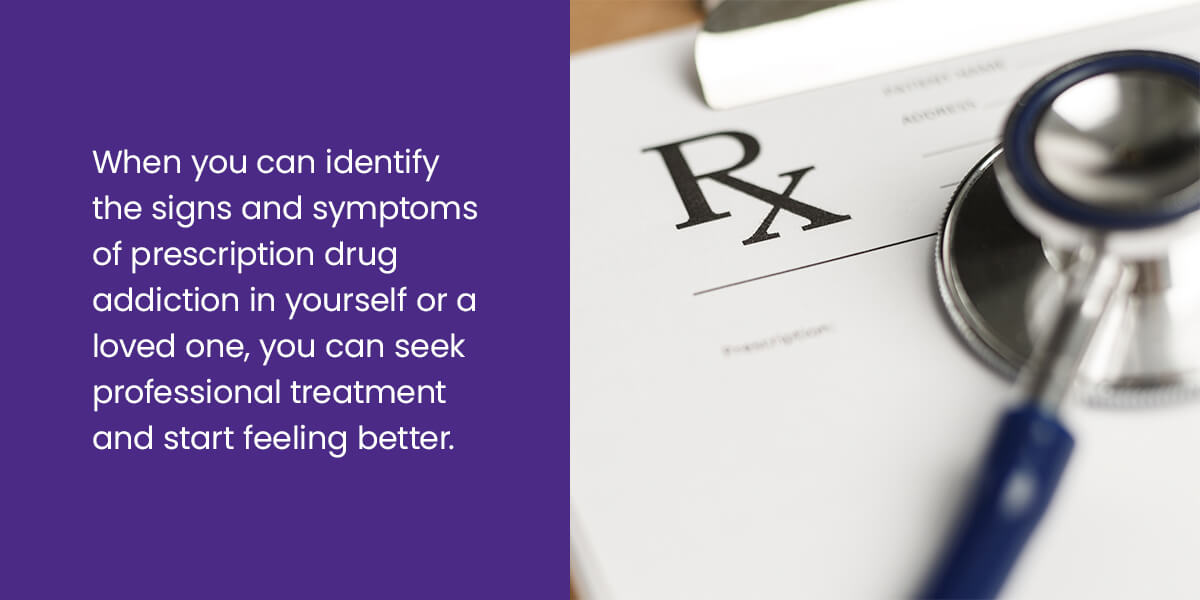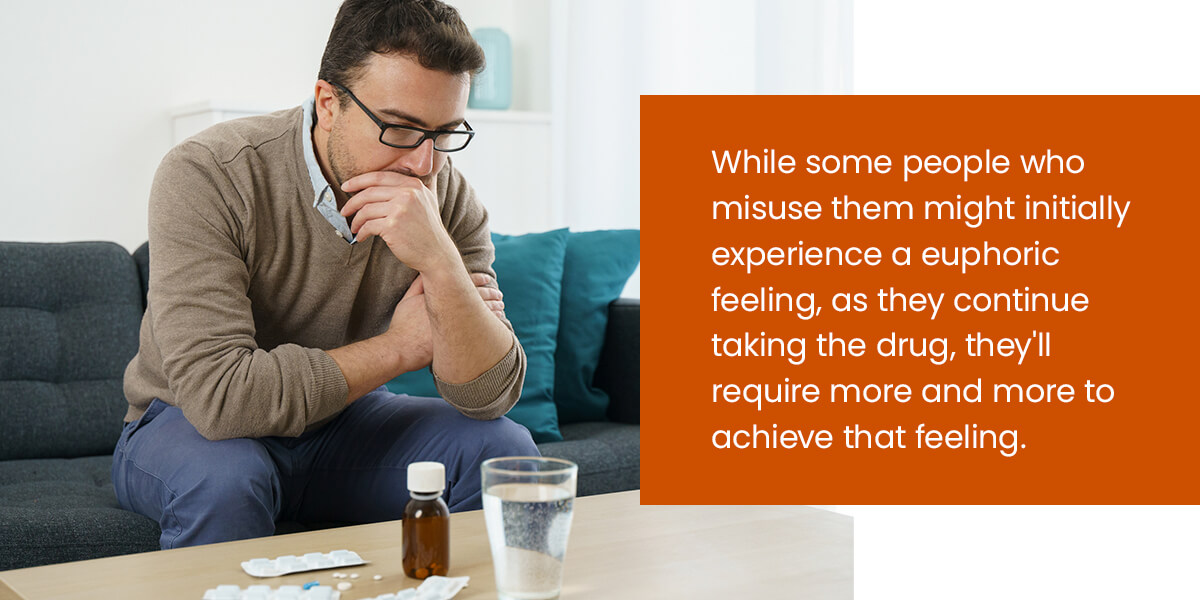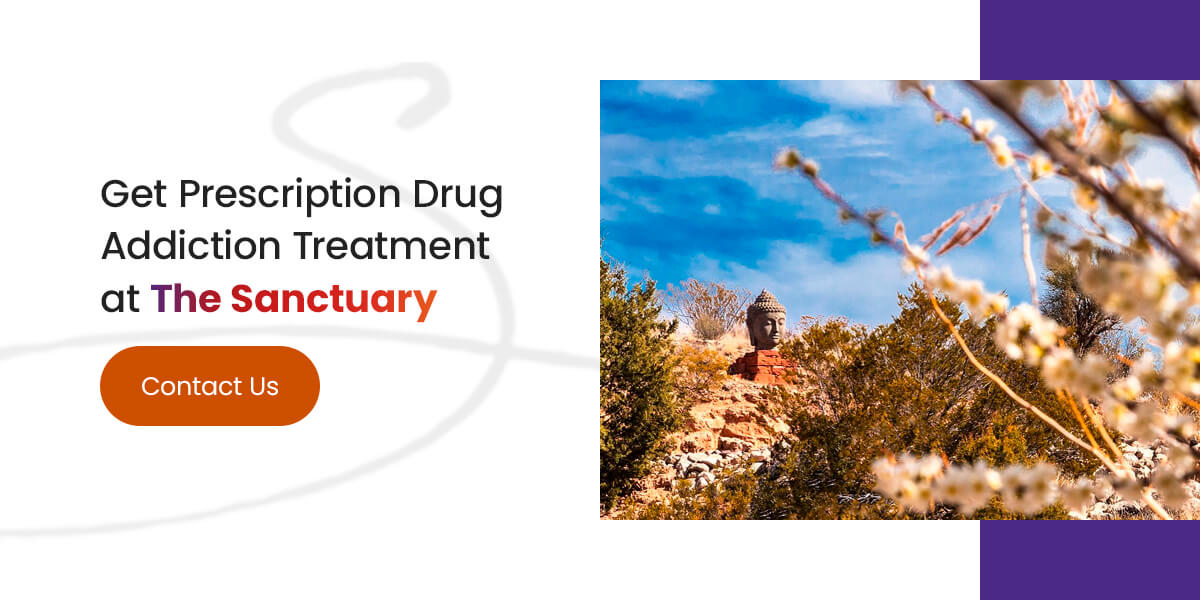Prescription drugs are some of the most commonly used substances in the United States. Approximately 16.1 million people have misused prescriptions, including painkillers or opioids, sedatives and stimulants. These medications can drastically alter brain chemistry, increasing a person’s risk for dependence and causing health complications when attempting to quit.
If you or someone you know is experiencing prescription drug addiction, know that recovery is possible. Learn the signs and symptoms of prescription drug addiction, risk factors and treatment options.
Signs and Symptoms of Prescription Drug Addiction
When you can identify the signs and symptoms of prescription drug addiction in yourself or a loved one, you can seek professional treatment and start feeling better.
It’s also important to realize that anyone can develop a drug addiction. For drugs like painkillers, an addiction can happen even when using the medication as prescribed by a doctor. Various prescription painkillers, like Vicodin, OxyContin and Percocet, can be used for those struggling with mild to severe pain, but they can also lead to a pattern of misuse.
When misused, prescription painkillers can initially elicit feelings of relaxation, detachment and euphoria before developing into full-blown chemical dependence.
The following are signs of drug addiction to look out for.
Behavioral Changes
When a person starts developing an addiction to prescription painkillers, they may exhibit these behavioral warning signs:
- Self-medicating anxiety and depression with prescription drugs like benzodiazepines
- Using prescription stimulants, like Adderall, recreationally
- Taking prescription opioids to numb uncomfortable emotions
- Diminished participation in meaningful activities
- Deception surrounding their whereabouts and activities
- Visiting multiple doctors for painkiller prescriptions
- Borrowing or stealing another person’s prescribed medication
- Withdrawing from all social activities and isolating from friends and family
Physical Symptoms
Prescription drug addiction can also cause various physical side effects, such as:
- Impaired coordination
- Pupil dilation
- Heavy perspiration
- Itchiness
- Constipation
- Slurred speech
- Decreased blood pressure
- Disrupted sleep patterns
Cognitive Warning Signs
As the brain changes and adapts to the drug, people can experience the following cognitive signs of prescription drug misuse:
- Confusion
- Disorientation
- Slurred speech
- Poor decision-making skills
- Learning and memory impairment
Psychological Symptoms
The psychological symptoms of prescription drug misuse to look out for include:
- Irritability
- Depression
- Paranoia
- Anxiety
- Drastic mood changes
Causes and Risk Factors of a Prescription Painkiller Addiction
There are several reasons misuse of prescription drugs can occur. Many people become addicted to prescription drugs unknowingly. For instance, you may go to the dentist for a toothache. The course of action might be painkillers to relieve the ache. However, with every prescription refill comes a risk of addiction, making it essential to follow a doctor’s orders very carefully.
Yet substance use disorder is often even more complex than this, with genetics and environmental factors also playing a role in the development of this disease.
Causes and risk factors of prescription painkiller addiction include:
The Drug Itself
Something seemingly harmless like taking medicines as prescribed can escalate into a habit.
Prescription painkillers and other prescribed medicines contain addictive properties that change the brain, making it difficult to stop taking them. While some people who misuse them might initially experience a euphoric feeling, as they continue taking the drug, they’ll require more and more to achieve that feeling.
This cycle can be complex for anyone to escape, regardless of whether they also deal with mental health issues or have a family history of addiction.
People can quickly develop a prescription drug addiction for these reasons, as well:
- To relieve physical and chronic pain
- To relax
- To control or numb emotions
- To help with focus or productivity
- To sleep
- To lose weight
- To avoid withdrawal symptoms
Genetics
Studies show genetics can have an impact on the development of addiction. If a person has a genetic disposition to impulsivity or thrill-seeking, this can put them at a higher risk for misusing substances. The genetic risk can cause addiction issues at any time throughout a person’s life.
Other research found that twins and adopted children with a biological parent with substance use disorder had an increased chance of experiencing similar issues.
Often, our environment can even cause changes to our genes, called epigenetic alterations. An example is the connection between stress hormones and the brain’s reward circuitry system. When under stress, we can experience changes in our genes linked to addiction development and stress-induced relapse in recovery.
Environmental Factors
When stressors like job loss, childhood trauma, academic pressure, a death in the family or other events happen that are outside of our control, people may self-medicate with substances.
There exists a strong link between painkiller addiction and trauma. Those who have experienced child abuse or other childhood traumas are at an increased risk of substance misuse, especially without the proper coping skills. They may turn to substances to numb their emotional pain, getting caught in a cycle that can be difficult to overcome.
Stressful changes in our environment can also lead to substance misuse. People living in poverty or high-crime areas might turn to substances like opioids in an attempt to escape.
Other environmental factors like a death in the family or the loss of a job can create a stressful environment conducive to drug misuse. Additionally, people with high-pressure academics and careers might believe that prescription sedatives or stimulants can ease their stress or help them perform better. That’s one reason why students and teens are at a higher risk of developing Xanax addiction.
Prescription Drug Addiction and Co-Occurring Disorders
Drug addiction and other mental health disorders often co-occur, meaning many people with addiction also have underlying mental health conditions like depression or anxiety. In fact, over 60% of teens in addiction treatment programs also meet the diagnostic criteria for another mental illness.
The reasons for this relationship can include:
- Certain drugs can cause people to experience one or more symptoms of a mental health condition.
- Mental health conditions can sometimes lead to drug use, as many people might use them as a form of self-medication.
- Mental and substance use disorders share underlying causes, like genetics, stress and trauma.
Common mental health conditions that co-occur with addiction include:
- Generalized anxiety disorder
- Depression
- Bipolar disorder
- Post-traumatic stress disorder (PTSD)
- Panic disorder
- Attention-deficit/hyperactivity disorder (ADHD)
- Borderline personality disorder
- Antisocial personality disorder
Addiction tends to start in youth, as adolescents transition into adulthood. This is a vulnerable time for young adults, as they face changes in school, work and relationships. Without the proper coping skills, they’re at a higher risk of depression and addiction. And as stated, painkiller addiction and trauma are often linked, with symptoms overlapping in victims of childhood abuse.
The overlap of co-occurring disorders can also be more pronounced in those with severe mental health issues that cause functional impairment, like major depression, bipolar disorder and schizophrenia.
Further, prescription drugs can cause paranoia, depression and anxiety when misused. When addiction sets in, many people often isolate themselves from friends and family, causing loneliness and depressive symptoms.
Effects of a Prescription Painkiller Addiction on Your Life and Those Around You
Regardless of why you start taking them, it’s essential to remember that all prescription drugs have side effects. Whether used illicitly or as prescribed, they can all come with a risk of addiction, especially when taken without medical supervision.
When addiction sets in, it can wreak havoc on a person’s livelihood, from their physical and mental health to those around them, including the most important people in their life.
The effects of misusing prescription drugs include:
- Social isolation
- Impaired or damaged interpersonal relationships
- Family problems, including separation and divorce
- Job loss and chronic unemployment
- Financial distress
- Homelessness
- Development of physical health problems
- Suicidal ideation
- Suicide attempts
- Legal issues, including arrest and incarceration
Addiction can also cause withdrawal symptoms that make it more challenging to quit. Symptoms can include:
- Fever
- Nausea and vomiting
- Loss of appetite
- Sleep problems
- Bones or muscle pain
- Powerful cravings
- Irritability and mood swings
- Tremors
Can You Recover From a Prescription Painkiller Addiction?
It’s important to know that recovery is possible if you are addicted to prescription painkillers. When a pattern of misuse begins, prescription drugs can alter brain chemistry and cause withdrawal symptoms when attempting to quit.
At The Sanctuary at Sedona, we understand how difficult it can be to defeat this cycle. For this reason, we believe a holistic protocol of supplements, medicine adjustments and therapies can restore the brain to its original chemistry. Going this route can accelerate the process of overcoming withdrawal and beginning your recovery journey.
Available Treatments for Painkiller Addiction
Many addiction treatment centers use an old clinical model that only treats the symptoms of an illness or addiction. At The Sanctuary, we believe in whole-system healing. By working closely with you, we deliver treatment that addresses all of your needs. Whether that’s conventional or alternative therapies, we view every treatment as integral to your recovery and overall health.
A holistic prescription painkiller recovery approach might include:
1. Supplements and Medication Management
Prescription drugs can cause uncomfortable withdrawal symptoms when misused for a long time. That’s why it’s essential to stop taking them with help from an addiction specialist. Health professionals will use supplements like IV therapy and a detox protocol to help you safely and gradually cleanse your body of these prescription medications. This way, your body can quickly return to a healthy state to begin recovery.
2. Nutrition and Exercise
Exercise and nutrition are vital components to a healthy life and recovery from addiction. An extended period of prescription drug misuse can weaken the body and deplete it of essential nutrients. The Sanctuary provides locally sourced organic, gluten- and dairy-free gourmet meals and snacks. At the same time, exercise can reduce stress, help you sleep better, improve mood and increase energy — all conducive to a successful recovery.
3. Clinical Evidenced Therapies
At The Sanctuary, we provide two individual therapy sessions a day. Our staff consists of 30 therapists, with eight who live on campus, meaning you’ll get more one-on-one time.
A few of the clinical evidence therapies we offer include:
- Cognitive behavioral therapy
- Gestalt
- Family and couples therapy
- Acceptance commitment therapy
- Eye movement desensitization and reprocessing (EMDR)
4. Alternative Therapies
Your treatment plan will vary daily, and you’ll meet with a treatment team daily to discuss your progress and goals. Your personalized daily schedule might also include powerful holistic therapies to help you recover, including:
- Breathwork
- Bodywork
- Nature ecotherapy
- Expressive art therapies
- Yoga
- Sound healing therapy
- Meditation
- Energy medicine
- Energy psychology
5. Aftercare
Aftercare is another essential component of prescription drug addiction treatment. When you leave The Sanctuary, we’ll monitor and coach you during your transition home to help you implement what you learned at the treatment center in your everyday life. With aftercare, you can work toward preventing relapse and maintaining your healthy coping skills and activities.
You’ll also be empowered to address any triggers to help you get back on track. You’ll remain part of The Sanctuary family for life.
Prescription Drug Addiction FAQ
Some of the most common questions we receive about prescription drug addiction include:
1. How Can I Treat Prescription Painkiller Addiction Naturally?
The Sanctuary at Sedona provides natural, holistic treatment methods, including a nutritious diet, exercise and therapies. You can work toward overcoming addiction naturally without medicines through alternative practices like yoga, breathwork and immersing yourself in nature. Further, cognitive behavioral therapy can help you recover by identifying your triggers and employing healthy coping mechanisms.
While doctor-prescribed medications might be necessary for you, many who enter our treatment programs find therapies that can help them.
2. What Are the Symptoms of Painkiller Overdose?
If you suspect someone you know is overdosing on prescription painkillers, call a health professional immediately. An overdose can lead to death, coma or other health complications. Symptoms might include:
- Breathing problems
- Pinpoint pupils
- Loss of consciousness
- Seizure
- Slow or irregular pulse
- Extreme disorientation
3. How Can I Help a Loved One With a Prescription Painkiller Addiction?
When you have a loved one struggling with prescription painkiller addiction, it can be very concerning. You know your loved one needs help, though you might not know how to help.
Remember that addiction is a disease that can be difficult to overcome, and being empathic can help them feel supported and loved. Avoid speaking to them in a judgmental tone when addressing your concerns and allow them to speak.
In 2020, approximately 16,416 people died from a prescription opioid overdose. Spending time learning about the effects of these and other prescription drugs, including warning signs of overdose, prepares you to help if necessary. Ensure you do not enable your loved one’s behaviors — set boundaries and encourage them to obtain treatment. Offering your assistance in helping them get to appointments or enter a treatment center can help.
When treatment starts, ask the professionals there how you can stay involved in your loved one’s life. There are also several ways you can encourage your friend or family member to continue aftercare once treatment is completed. You might become a part of their support system and encourage them to continue counseling.
Get Prescription Drug Addiction Treatment at The Sanctuary
Prescription drug addiction can be challenging to overcome, but it’s essential to know that you are not alone.
The Sanctuary at Sedona provides integrative, holistic treatment to help you live a healthier, more meaningful life. Our non-12-step rehabilitation approach focuses on evidence-based therapies and science-backed research to treat prescription drug addiction in a safe, supportive environment.
To learn more about our treatment process, contact us today.





